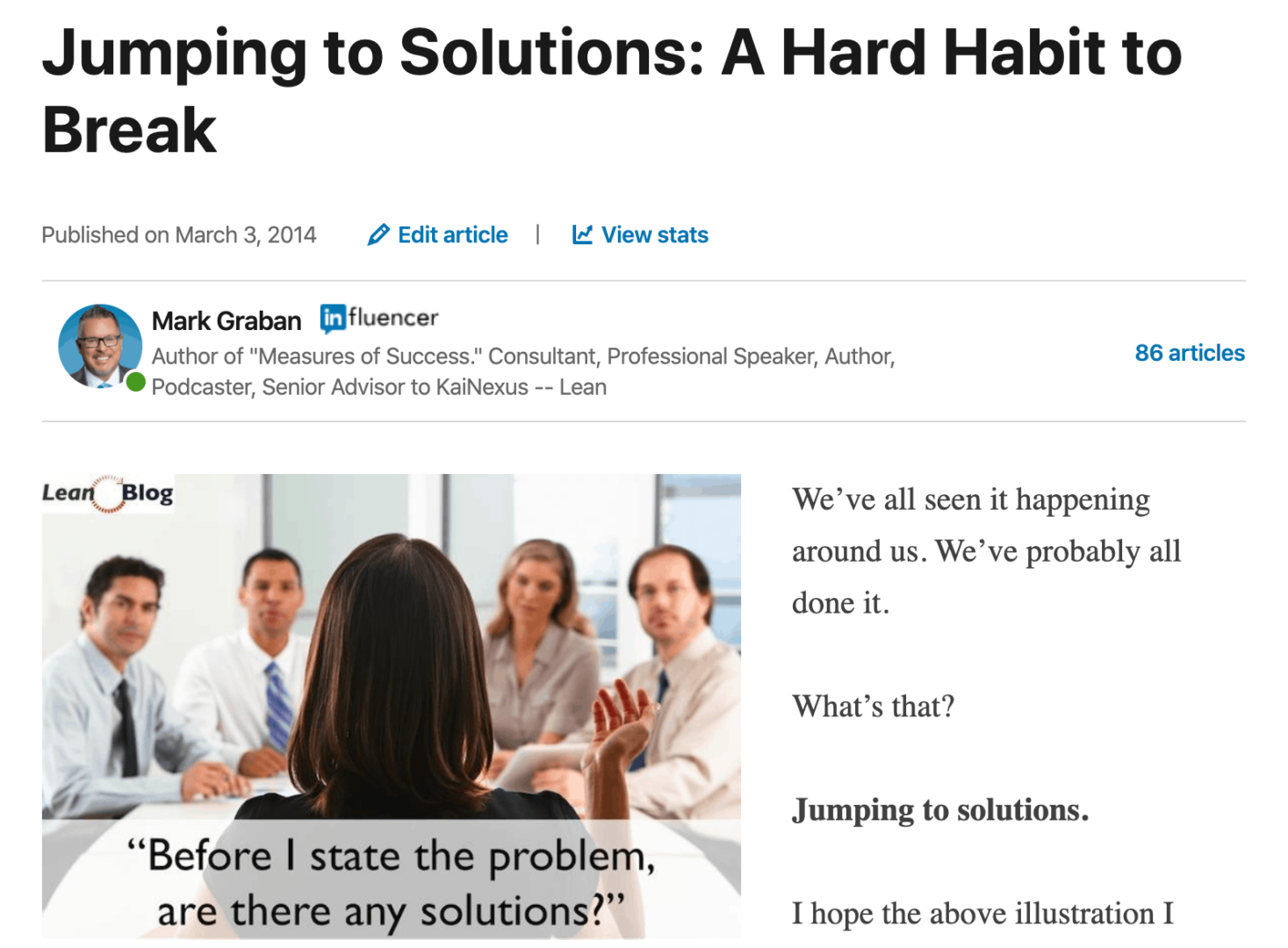No, this isn't a post about the the 80s Chicago tune “Hard Habit to Break.” It's about individual habits related to problem solving that are hard to break.
As Charles Kettering (the famed engineer of General Motors and the namesake for my dad's alma mater, Kettering University, the former GMI) said:
“A problem well stated is a problem half solved”
In Lean problem solving models, including PDCA/PDSA and the A3 methodology, the focus is on not jumping to solutions too quickly… and it's a hard habit to break, for all of us.
Defining a problem well includes understanding the current state. We need to understand the gap between what should be happening and what is actually happening. We then work to understand the root cause of the problem…
Immediately jumping into solutions brainstorming can really short circuit good problem solving. We can waste time going down rat holes, discussing ideas that don't address the root cause and won't really address the issue we've come together to discuss.
I've tried focusing on this approach for a long time, but I still find myself jumping to solutions at times… but I generally try to be aware of it.
I think people tend to go through this progression:
- I'm unaware that I'm jumping to solutions
- I'm aware of it, but I keep talking about solutions anyway
- I'm aware of it and I can stop and refocus on problem definition
Does anybody ever get to a “step 4” of never jumping to solutions? I think that would be the sign of a really disciplined Lean problem solver.
What's your own experience with this?
Updating this to include a link to a 2014 article I wrote for LinkedIn:

Please scroll down (or click) to post a comment. Connect with me on LinkedIn.
Let’s build a culture of continuous improvement and psychological safety—together. If you're a leader aiming for lasting change (not just more projects), I help organizations:
- Engage people at all levels in sustainable improvement
- Shift from fear of mistakes to learning from them
- Apply Lean thinking in practical, people-centered ways
Interested in coaching or a keynote talk? Let’s talk.
Join me for a Lean Healthcare Accelerator Trip to Japan! Learn More










Great blog today, Mark, and very timely for me. I’m team teaching in Pittsburgh, and we’re covering Current Condition today with these hospital staff members, and we read from this today and cited you. Thanks!
It sounds like going through grief. 1. Awareness. 2. Denial. 3. Acceptance.
I still catch my self in phase 3 from time to time. It is human nature to jump to conclusions. The key is to be conscious of it and get back on track.
Hi Mark
By nature or by past experience many of us tend to jump to solving problems before getting all the information required. We want to prevent a problem from reaching the customer. That being said, I like the concept of finding at least a temporary quick fix when there is a problem, then afterwards taking the time to make sure that the fix addressed the root cause, if not then developing a solution that will.
I am not so worried about finding quick fixes when there are problems, but you need to have the post fix discipline to analyze the problem and ensure you found any and all possible root causes and addressed them with permanent changes, including if need elimination or adjustment of the quick fix. It is not following through to find the root cause after taking quick action that will leave you open to future problems. This is just part of a good PDCA program, you never assume it is fixed till it proves that it is fixed, it also looks after your customers interest, because you took quick action, and then took actions to ensure it does not repeat.
You cannot always wait to do something when problems first occur, if you care about the customer. But after taking the first action you should follow through with one or more PDCA cycle to ensure it is fixed for good.
I agree with Robert. Sometimes you need to put in a temporary countermeasure to contain the problem and stop the problem from spreading.
Most companies stop here and that’s where they get into trouble. The key is to take the next step and drive to root cause(s) and put permanent countermeasures in place. That’s the part that takes discipline.
Yes, Al and Robert. Short term containment is often a very important part of the fuller problem solving process.
Some industries do a lot of containment without ever working on the root cause to prevent future instances. I’ve seen cases where hospitals ignore the containment to work on the longer-term fix (whether they are using effective long-term countermeasures that address the root cause, or not).
If a wrong medication gets to a patient, there needs to be immediate action to make sure more medications don’t occur. We might temporarily add staff to go back and confirm every medication that’s currently in process, but that’s not likely to be a good long-term countermeasure.
Put the fire out then talk about fire prevention, right?
I feel like society today as a whole places focus on “action” “go do” and results. I always hear “get out there and go do”. When was the last time you heard “go take a quite moment outside to reflect on the possible root causes”? The nature of the world today isn’t reflection, talk, and analysis around a problem – it is jumping right to solutions/fixing.
As with Nadia, I also find this article timely as I am presenting doing a large baseline/current state exercise at work. Understanding where our true issues lay before deploying resources to fix it.
I hear what you’re saying, Christina. We prize action… but the quick solutions often don’t end up really being solutions.
When I hear people say “I’m sorry I’m talking about solutions…. I just love problem solving!” I often think, “No, you don’t like problem solving at all… you like brainstorming solutions!!!”
Different definitions of what “problem solving” means, I guess.
Very good point in your blog. I find that “problems” are often stated as “The hospital administration needs to build more parking” or “We have to teach patients how important it is not to miss their appointments.” As I point out in my presentation on “Converting Data into Information” (http://www.jamesmsmith.org), this is primarily because staff are so motivated to solve the problem that they immediately think of a fix to a perceived problem and then state the problem as not implementing their fix. The problem statements above are not problem statements but rather proposed solutions to some perceived problem. Not only does this miss identifying exactly what the problem is but it also suffers because the problem statement itself affixes blame on someone, “the hospital administration” or “patients” in the above examples. Starting a problem resolution discussion by blaming someone for the problem is a very poor way to start.
Yes, excellent point. I agree that stating a solution is not a good problem statement. I have to coach people on that all the time. Thanks for sharing those examples.
Mark, this is a fascinating topic that deserves discussion. I feel the root of premature problem solving is a function of formal education, where we’ve been taught that for every problem there is one and only one right solution. Convergent thinking is OK for test taking, but in real life, for many problems, we need to diverge thoughts across many disciplines and synthesize knowledge. In other words, problem solving requires that we think at the highest levels of Bloom’s taxonomy. Far too often, in team situations, group think grabs ahold and short circuits the problem-solution cycle.
Like it or not we’ve all been conditioned from an early age to “just do it.” And so – all too often – we do.
First, I agree with the premise. I said many times that if I were to take one skill from continuous improvement and bring it into K-12 education, it would be the ability to define the problem well.
Second, just because I like to give credit where credit is due, it wasn’t Kettering who first made this claim, it was John Dewey: “A problem well stated is half-solved.”
John Dewey also had thoughts on habits http://www.alexandercenter.com/jd/johndeweyhabits.html
Habits drive behavior much more than logic. http://management.curiouscatblog.net/2009/12/10/habits/
Many of us (stubborn) baby boomers find it difficult to adjust at times. We remember how problems were solved in the olden days, with experience. I agree that there are time for RCCA’s, A3’s and 5 whys. For experienced employees many of the problems really are simple and the solutions really are obvious. At times we as lean practitioners beat back this fact in cult like fashion. Every (exaggerating) problem doesn’t need a picture and a committee to solve. I really enjoy practicing lean however Bob in accounting might just have the answer if you ask him.
Yes, you’re right. Not everything requires complex problem solving.
If the printer is facing the wrong direction on the nurses’ station counter, we can just turn it around, “quick and easy kaizen” style. We don’t necessarily need to do a Root Cause Analysis to understand why.
In complex system kaizen situations, jumping to solutions can be a big waste of time if we haven’t fully understood the problem.
At my hospital we had a ‘roll-out’ of a program to reduce complications(primarily infectious) from
Foley(urinary bladder) catheters sent as a slide-show e-mail:
1) No rationale for timing of this initiative.
2) No information about this problem at my hospital(I’m not an MBA, but I thought one first had
to understand severity of the problem locally prior to ‘fixing’ it. This might be a solution in search
of a problem?
3) No mention of a monitoring plan to measure effectiveness of initiative nor any plans for ‘feedback’ about effectiveness of this program.
4) No mention of initiatiator(s) of this initiative.
5) No mechanism for comments prior to starting program.
Any comments…?
Ken
Ken – sorry to hear your story. That doesn’t sound like an ideal model of staff/physician engagement or change management, not in the least.
I wouldn’t expect that “roll out” to be successful… sounds, sadly, like more of a ROLL OVER than a roll out.
A key part of problem solving is engaging team members in the solution to the problem. That means face to face time with structured dialogue following a process or problem solving methodology.
Seems like many of these components are missing in this example and I’d guess the probability of sustaining is pretty low.
Beyond expected poor sustainment, I’m guessing this change might not even be accepted or adopted much in the first place… other than maybe some lip service. Hard to sustain what you don’t really start properly…
I too have been doing a lot of thinking about this. During my MBA class One of the concepts I teach the difference between a Problem, Root Cause, and Solution. I put statements on the test and ask them to pick which one the statement applies to. (Problem, Root Cause, or Solution). I would say only 10% get them all right.
I have tried to determine why this is the case. My current theory is that our brains are actually hard-wired to be problem solvers, and it’s not that we are bad at it – it is just that we go so fast through the steps that it is unconscious. It is very hard for people to go back and think of how they solved a problem. It happens too naturally. This is fine when you are solving problems on your own, but when you are working on a team or looking at complex problems, this is not ideal at all.
Physician friend of mine, the master of the pithy comment, came to really embrace the importance of detailed and honest observation before moving into problem-solving. He stated it this way: “Don’t just do something–stand there!”
I am sure that many on this site are like me and are Health News junkies. Right now, neuroscience is publishing paper after paper (and books: The Power of Habit Charles Duhigg) how the chemical flood of the reward center in the brain is essential in understanding addiction, obesity, procrastination, follow-through, habits…etc. It is easy to see in me and in my clients the reward rush that comes with solutions. It is satisfying and exciting. I am working with one hospital exec that through the years when “Hail Mary” solutions pop up during a meeting, there is a light that goes off in his eyes. He starts pacing the room “we can do it. We can do it. 3 shifts a day, but we can do it.” Solution jumping is a rush.
So to create a stronger, more productive habits, we need to identify the “reward.” This same exec gets a little light in his eyes from rounds – gemba walks, sort of. Connecting the dots by talking with line workers and patients gives some reward. Can that be cultivated to a “rush”? So my contribution to this blog is instead of beating ourselves up for lack of discipline on jumping to solutions, can we cultivate more productive habits of understanding and cultivating rewards?
Outstanding insight Joye. . . I totally agree. . . Positively reinforce the good habits.
I often jump to considering causes, which I think it better though maybe still premature. Also though for simple things jumping to solutions is fine in my opinion. It isn’t perfect, but everything is a balancing act. If invest in following a full, formal, process for simple stuff you won’t have time to do so on the enough areas.
The judgement to know when to do a quick fix and when to do something more time consuming is key. 5 why is really nice because in 2 minutes you can often get a decent idea if a quick fix is ok or you really are just putting on a band-aid for a small sub-set of the issues and you really are leaving a problem generating system in place – or even realize you just don’t know (in which case I would be biased toward saying you should investigate further).
This weekend’s WSJ has a story about teaching medical students to slow down:
LINK
Yale’s School of Medicine has medical students go to an art museum to learn to really look and describe a painting as a way of learning how to diagnose.
“We are trying to slow down the students,” Ms. Friedlaender told me. “They have an urge to come up with a diagnosis immediately and get the right answer.”
[…] Executed) or not implementing problem solving and optimization from the top levels, or even jumping to conclusions without properly defining the problems ran […]